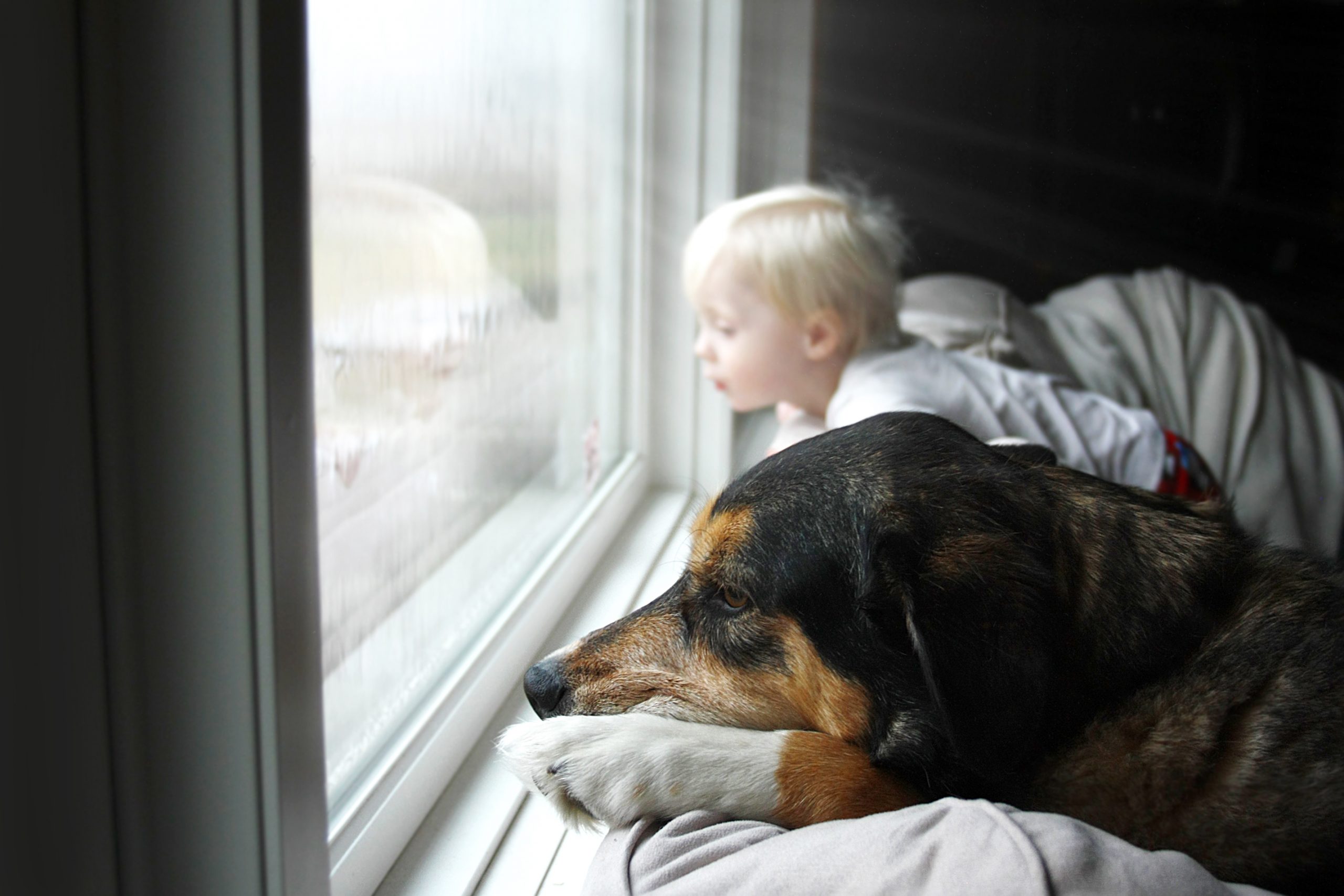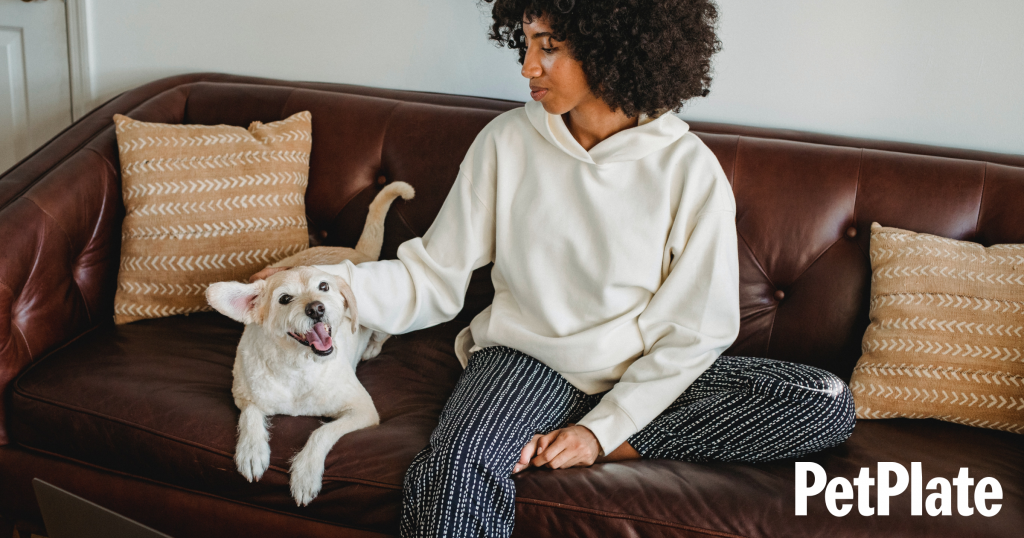
Many of us look forward to July 4th festivities punctuated by food, family and fireworks. These time-honored traditions are enjoyed by most, except for some of our furry friends.
It is not unusual to have a dog that is frightened by loud noises. After all, loud noises are one of the biggest causes of anxiety in pups. To your pooch, the booming of thunder and fireworks can seem like a very real threat. Unfortunately, because we cannot prevent these loud noises, we must learn how to detect anxiety within our dogs, and help reduce their overall stress.
Since storms and fireworks are inevitable sources of stress in summer months, we’ve provided this step-by-step guide for addressing noise-induced anxiety.
How to Tell if Your Dog is Stressed
How to Calm Your Dog’s Nervous Behavior
What to do if Your Dog is Afraid of Loud Noises
How to Prevent Anxious Behavior
How to Tell If Your Dog is Stressed
The signs and symptoms of noise induced anxiety can vary significantly from dog to dog. Like humans, pups tend to have their own coping methods when under stress. For example, some like to pace around aimlessly, while others may find a quiet space to hide away.
There are some common signs you can look out for. For example, if you notice some of the following behaviors in your dog during a storm, they’re likely experiencing anxiety.
- Barking or whining
- Panting
- Trembling
- Drooling
- Pacing, seeking attention
- Hiding
- Urinating or defecating
How to Calm Your Dog’s Nervous Behavior
Here’s a step-by-step guide on how you can help reduce the stress and anxiety of a storm. For the best results, try to do the following before the storm’s arrival.
- Create a safe space. This could be where they sleep or a room that’s isolated from the noise of the storm. If there’s a place your dog always goes to when they’re anxious, this could work too.
Filling the area with their favorite blankets and toys can help to reassure your dog. You can also place some of your old clothes in there, too – your scent can help comfort your pupper further. Once you’re all set up, you can close any doors or windows and stay with your pooch for the time being. - Play some background noise. This can help to cancel out the sounds of the thunder outside. If there’s a TV in the room, you could use this – otherwise, you could maybe use your phone to play music or white noise. Whichever method you use, don’t crank up the volume too loud! We don’t want to fight loud noises with even louder noises. So instead, keep the volume at a level that’s just enough to muffle some of the light thunder.
- Give them a massage. Long, slow strokes across the spine will calm their nerves. Be cautious, fast pats and aggressive strokes will only serve to stimulate, which can potentially make them more anxious. Instead, place your palm on your dog’s head and make long strokes across their back without stopping. Start with a light amount of pressure. If your dog is comfortable, you can be a little firmer – just take care to not be too forceful!
- Use toys to distract or play. If your dog has too much energy, try and redirect it away from the storm. Try and offer one of their toys and see if they’d like to play with you! If your dog isn’t engaging, don’t force it. Instead, you can offer them a chew toy or something similar – this can give them something to calmly focus on.
- Hide Visible Stressors. While thunder is the main culprit of storm anxiety, flashes of lightning can also scare your pooch. So it’s a good idea to pull the shades or draw the blinds on any surrounding windows.
Why are Dogs Afraid of Fireworks & Thunder?
Dogs are naturally fearful of loud noises, like fireworks, for good reason. Biologically, fireworks and other loud noises can trigger a fight-or-flight response in our dogs. The loudness of the fireworks, combined with their unpredictability, can make the fireworks appear especially threatening to our dogs, who don’t understand why the noise is happening.
Dogs with a flight reaction to fireworks can end up feeling trapped because they can only run away from the threat inside your home. Unfortunately, the noisy fireworks can still easily be heard from inside.
For dogs that have a fight reaction to unexpected noises, you may notice that they start to bark at the fireworks or present agitated symptoms, such as pacing, whining, restlessness, and panting. With either response, your dog’s inability to escape fireworks and thunder intensifies their anxiety response.
Put yourself in their paws. Aren’t you concerned when you hear sudden unexpected loud noises and bright flashing lights? In addition to the fear of the unknown, dogs have trouble rationalizing noises that occur in different patterns, intervals, and directions, making the noise even more distressing.
Why is My Dog Afraid of Fireworks But Not Thunder?
It can be confusing for pet parents when they notice that their dog is afraid of fireworks, but not thunder. These two situations are similarly noisy to us, but to our pups, there is a significant difference between the two.
The most significant difference between the two is thunderstorms have many warning signs, while fireworks do not. Our dogs have acute senses that allow them to pick up on changes in barometric pressure and the wind, cluing them in that a storm is coming.
However, fireworks have no warning signs, making them more intimidating to our pups. The suddenness of fireworks can startle a dog, resulting in an increase in stress hormones, adrenaline, and heart rate.
How to Prevent Anxiety in Your Pooch
Create a Calm Space
While it’s unlikely that you’ll be able to block out the noise from fireworks or thunder completely, you can muffle the noise for your dog.
Make sure all doors and windows are closed. Allow your dog to snuggle up with a thick blanket in their bed, crate, on the couch, or wherever they feel most safe. Double-check that the crate is not locked so that your dog doesn’t feel trapped should their fight-or-flight response kick in. You can also play calming music loudly or use a white noise machine to mask the noise of the fireworks.
Set the mood with calming scents. Use sprays specifically made with aromas that appeal to your dog’s senses. A couple of sprays around the room should be all you need.
Alternatively, you can use an essential oil diffuser. However, this method requires extra care, as the essential oils can be toxic if ingested or diffused in heavy quantities. You will need to significantly water down the oil and use a passive diffuser only to spread a low amount of the scent. Do not use a diffuser in a small space and keep it out of reach of your dog. It’s also a good idea to only use the diffuser for a short period of time – just enough so that your dog will be able to smell it.
Another great option is to provide a distraction. Give your pup their favorite toys and a special goodie to keep them occupied during the firework show. A KONG or puzzle toy is ideal because it’ll keep your dog focused on getting to the hidden treats or peanut butter inside.
Try a Thunder Jacket
Also known as an anxiety vest, a thunder jacket is a piece of doggie clothing that applies light pressure to the back and sides. This offers a similar effect to the petting method we outlined earlier – gentle, continuous pressure can help your dog feel calm and safe.
We’d also recommend using specially-made dog earmuffs. While these won’t cancel out the sound of thunder, it will muffle it. Combining thunder jackets for dogs with quality ear muffs can have a significant effect.
However, be sure to train your pup to accept these items beforehand. Your dog will find them strange at first – trying to put them on for the first time during a storm will only stress them out further. Don the dog thunder shirt and earmuffs on your pup regularly, offering treats for good behavior. After some time, they should be fully comfortable with both.
Consider Medication
If your poor pup has particularly severe anxiety when it comes to thunder, and the above methods and tools do little to help, you may need to think about medication. A short-term solution can be found with Benadryl, an over-the-counter antihistamine. It can act as a mild sedative, keeping your pooch calm for the duration of the storm.
For more severe anxiety, your pup may need a daily dose of vet-approved anxiety medication throughout the storm season. Such medicine may need to be started a month before storm season begins to ensure it has enough time to take full effect. As always, speak to your vet before giving any kind of medication to your dog.
Optimize Your Pup’s Schedule
If you know that fireworks or thunder are imminent, plan your dog’s meal and potty time out accordingly.
Most dogs with a fear of loud noises will not want to go outside while the sky is rolling with light and sound, and you definitely don’t want to drag a terrified dog outside. So, give your dog their dinner early, and give them plenty of time to go potty before the things get hectic.
We also recommend wearing your dog out. A sleepy dog is less likely to panic. Schedule a long play session, walk, or hike with your dog, so they are more interested in napping than overreacting. Even if this doesn’t lead to a nap, they’ll be less likely to exacerbate the situation with nervous pacing and howling.
Speaking of Feeding Time
When your dog gets anxious, it is important to counteract their stress with activities and treats to shift their mood. PetPlate’s training treats, supplements and fresh meals are a sure way to boost your dog’s mood, and provide positive reinforcement to help them adapt to common stressful triggers.
